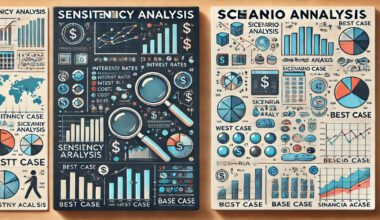Summary: What-If analysis in Excel enables users to evaluate different outcomes based on variable changes. By utilising Scenario Manager, Goal Seek, and Data Tables, you can make informed decisions in various financial contexts, enhancing overall analysis efficiency.
Introduction
With over 1.1 billion people using Microsoft’s Productivity Services, including Excel, it’s clear that Excel is an essential tool for many. What-If Analysis in Excel is crucial in decision-making, helping users explore different outcomes based on variable changes.
This guide aims to help you understand and effectively apply What-If Analysis in Excel, improving your ability to make informed decisions by easily evaluating various possibilities. Whether you’re managing budgets or forecasting sales, this analysis is invaluable.
As you already know, knowing how to use Excel is crucial. If you are interested in becoming a certified Microsoft Excel Expert.
Key Takeaways
- What-If Analysis in Excel helps users explore how input changes affect outcomes, improving decision-making.
- Key tools include Scenario Manager, Goal Seek, and Data Tables, each serving distinct analytical purposes.
- Properly organising data is essential for accurate and effective What-If Analysis, leading to reliable results.
What is What-If Analysis in Excel?
What-If Analysis refers to exploring the effects of different assumptions or input values on a model or formula in Excel. Using tools like Scenario Manager, Goal Seek, and Data Tables, you can determine how changes in specific variables impact the final result.
This feature simplifies decision-making by allowing you to forecast various outcomes without altering the original data.
The benefits of using What-If Analysis in Excel are:
- Improved Decision-Making: You can evaluate different scenarios and choose the best outcome based on varying inputs.
- Risk Assessment: Helps identify potential risks by showing how changes in one factor affect overall results.
- Time Efficiency: Quickly test multiple scenarios without manually adjusting and recalculating values.
- Error Reduction: Minimises calculation errors by automating the process of input changes and result predictions.
- Financial Planning: Assists in creating more accurate budgets, forecasts, and cost assessments by analysing multiple outcomes.
- Enhanced Problem-Solving: Provides a clearer view of potential solutions by comparing different assumptions.
- Scenario Comparison: Easily compare strategies or plans to find the most optimal choice.
- Versatility: Applicable across various domains like budgeting, investment planning, and project management.
Learn about essential keyboard shortcuts in Excel and their use in Data Analysis.
When to Use What-If Analysis
What-If Analysis allows you to change inputs and see how these changes affect results, helping you anticipate future trends or solve complex problems with multiple variables. Here are some key situations where What-If Analysis can be effectively used:
- Business Forecasting: Use What-If Analysis to predict future sales, expenses, or profit margins based on market conditions or pricing strategies.
- Budget Planning: Analyse different budget scenarios by adjusting variables such as costs, revenue, and savings to see how these affect the overall financial outcome.
- Project Management: Assess the impact of timeline changes, resource allocation, or budget shifts to understand their effect on project completion or delivery.
- Investment Analysis: Evaluate the potential Return On Investment (ROI) by changing factors like interest rates, inflation, or investment duration to choose the best financial strategy.
- Loan and Mortgage Calculations: Use What-If Analysis to determine how different interest rates, loan terms, or down payments impact your monthly payments or overall loan cost. You can also use a mortgage payment calculator for this purpose, allowing you to quickly estimate monthly payments based on different interest rates, loan terms, and down payment amounts.
- Production and Inventory Management: Analyse production volumes, material costs, or labour expenses to optimise inventory levels or maximise manufacturing efficiency.
In these scenarios, What-If Analysis allows you to visualise the impact of various inputs, enabling better decision-making in both personal and professional contexts.
Here are some more step-by-step guides for you to explore:
- Creating Waterfall Chart in Excel: Step-by-Step Tutorial.
- Stacked Waterfall Chart in Excel: Step-by-Step Tutorial.
- A Step-by-Step Guide to How to Lock Cells in Excel.
Guide to Using What-If Analysis in Excel
The three main types of What-If Analysis in Excel are Scenario Manager, Goal Seek, and Data Table. Each tool enables users to model multiple scenarios, explore possible outcomes, and make informed decisions. Now, I’ll walk you through a step-by-step process for using these three What-If Analysis tools.
Step 1: Prepare Your Data
Properly organising your data is crucial for the accuracy and efficiency of What-If Analysis in Excel. The foundation of any effective analysis starts with clean and structured data. Here’s how you can prepare your data for What-If Analysis:
- Ensure Data Accuracy: Before starting with What-If Analysis, ensure your dataset is error-free. Double-check the figures, validate sources, and correct any issues in data entry. Inaccurate data will lead to faulty analysis and unreliable projections.
- Label Your Data Clearly: Labelling is essential for clarity, especially when working with large datasets. Name each column and row, and use labels that are easy to understand. This will help you navigate your spreadsheet effortlessly when selecting cells for analysis.
- Set Up Input Fields: Identify the cells that will serve as your input variables—these are the numbers or values you will modify during the analysis. For example, if you analyse a business forecast, these variables might include sales volume, unit cost, or interest rates.
- Create Formulas for Outputs: To get meaningful results from What-If Analysis, you must set up formulas that depend on your input variables.
For instance, you might calculate total revenue using a formula like =Sales Volume * Unit Price or profit using =Revenue – Costs. These formulas will automatically update based on changes to your input variables during the What-If Analysis.
By organising your data this way, you’ll be ready to leverage Excel’s tools effectively and avoid any confusion during your analysis.
Step 2: Access What-If Analysis Tools
Now that your data is prepared, the next step is to access the What-If Analysis tools in Excel. Excel offers three key tools for this analysis: Scenario Manager, Goal Seek, and Data Tables. These tools are available in the Data tab on the Excel ribbon.
Here’s how to access them:
- Open Excel: Launch Excel and open the spreadsheet where you have your data organised.
- Go to the Data Tab: Click on the Data tab at the top of the screen.
- Locate the Forecast Group: The Forecast group, which contains the What-If Analysis drop-down menu, is located in the Data tab.
- Explore Your Options: Click on What-If Analysis to open the drop-down menu, which contains three options: Scenario Manager, Goal Seek, and Data Table.
You are ready to use these powerful tools to perform your What-If Analysis in Excel.
Step 3: Performing Scenario Analysis
Scenario Manager is an excellent tool for comparing multiple sets of inputs and determining how they affect your results. It is especially useful for evaluating best-case, worst-case, or middle-ground scenarios for business projections or personal financial planning.
Here’s how you can use Scenario Manager:
- Open Scenario Manager: From the What-If Analysis menu, select Scenario Manager.
- Add a New Scenario: In the Scenario Manager window, click Add to create a new scenario. Name the scenario appropriately, such as “Best Case” or “Worst Case,” to reflect the specific situation you’re analysing.
- Define Input Cells: In the Changing Cells field, specify which cells you will modify in each scenario. These are the input variables you set up earlier, such as sales figures, costs, or prices.
- Input Scenario Values: Once you’ve named the scenario and selected the changing cells, define the values for each scenario. For example, in the Best Case scenario, you might increase sales by 20% while reducing costs. In the Worst Case scenario, you might assume a 10% drop in sales and an increase in costs.
- Review Results: After entering the values for all scenarios, you can easily switch between them to see how the different input sets affect your outputs. To compare results side-by-side, click on the Summary button to generate a report showing the outcomes for all your scenarios.
Using Scenario Manager, you can assess potential outcomes and make data-driven decisions.
Step 4: Applying Goal Seek
Goal Seek is an intuitive tool that helps you work backwards from a desired result to determine the required input. It’s perfect for situations where you know the target value you want but don’t know how to reach it. For example, you might want to determine how much sales volume is needed to hit a specific profit target.
Here’s how you can use Goal Seek in Excel:
- Open Goal Seek: From the What-If Analysis menu, select Goal Seek.
- Set Your Target Cell: In the Goal Seek dialogue box, choose the cell that contains the formula you want to adjust (e.g., your profit formula).
- Define Your Goal: In the To Value field, enter the target value you want to achieve. For instance, if you want your profit to be $50,000, input 50000 in this field.
- Set the Input Variable: In the By Changing Cell field, select the cell that contains the input variable you want to adjust (e.g., sales volume). This is the variable that Excel will modify to achieve your target goal.
- Run Goal Seek: Click OK, and Excel will calculate the required input value to achieve your desired outcome. It will automatically update the input cell to show the value needed to hit your target.
With Goal Seek, you can quickly determine what adjustments are needed to meet specific business or financial goals.
Step 5: Creating Data Tables
Data Tables in Excel allow you to analyse how changing one or two variables affects the results of your formulas. This is particularly useful when you need to see a range of outcomes based on different input values, such as how changes in interest rates impact loan payments.
There are two types of Data Tables in Excel: one-variable and two-variable. Let’s explore how to create and use both:
- One-Variable Data Table: A one-variable Data Table shows how changing a single input value affects multiple outputs. For instance, you might want to analyse how different interest rates affect your monthly mortgage payments.
Steps to create a one-variable Data Table:- Set up your formula and list the input values (e.g., different interest rates) in a column.
- Select the range of cells that includes your input values and formula output.
- Go to the Data tab, click on What-If Analysis, and select Data Table.
- In the Data Table dialogue box, enter the reference for the input cell (e.g., interest rate cell).
- Click OK to generate the table showing how the input values affect the formula output.
- Two-Variable Data Table: A two-variable Data Table allows you to evaluate how changing two input values affects a single result. For example, you might want to see how different combinations of interest rates and loan amounts impact monthly payments.
Steps to create a two-variable Data Table:- Arrange your formula, placing one set of input values (e.g., loan amounts) in a row and the other set (e.g., interest rates) in a column.
- Select the table range that includes both input values and the formula.
- Open the Data Table option from the What-If Analysis menu.
- Enter the appropriate references for both input cells (e.g., loan amount and interest rate).
- Click OK to generate a table displaying how the varying input combinations affect the output.
Data Tables lets you quickly analyse multiple outcomes, providing insights into how different variables impact your results.
Do you know you can also use AI in Excel for smart solutions?
Advanced Tips for What-If Analysis in Excel
Once you’ve understood the fundamentals of What-If Analysis in Excel, it’s time to elevate your skills with advanced techniques. These strategies will enhance your analytical capabilities and streamline your workflow, allowing you to derive more meaningful insights from your data.
Here are some valuable advanced tips to help you maximise the potential of What-If Analysis in Excel.
Visualise Scenarios with Charts
Integrating charts into your What-If Analysis makes it easier to comprehend complex data. After creating different scenarios, use Excel’s charting tools to visualise your results.
For instance, if you’re analysing sales projections under various market conditions, a line chart can clearly show how variable changes affect sales over time. Visual representation helps stakeholders quickly grasp the implications of your analysis, enabling more informed decision-making.
Utilise Conditional Formatting
Conditional formatting is a powerful tool that highlights critical changes in your data. After performing a What-If Analysis, apply conditional formatting to your results to draw attention to significant variations.
For example, you can set rules that change the colour of cells based on specific thresholds. This visual cue helps you quickly identify best-case or worst-case scenarios, facilitating faster analysis and review.
Automate with Macros
If you frequently perform the same types of analyses, consider automating the process using macros. Macros allow you to record a sequence of actions in Excel and replay them with a single command.
This can save you significant time, especially when running multiple scenarios or revisiting previous analyses. For example, you can create a macro that automatically generates various What-If scenarios and formats the results, streamlining your workflow.
Experiment with Complex Models
What-If analysis can also be applied to more intricate financial models, including cash flow forecasts, investment analyses, or operational budgets. By leveraging tools like Scenario Manager and Data Tables, you can test various input combinations across multiple variables. This helps you understand the interdependencies between factors, allowing for more robust forecasting and risk assessment.
Combine What-If Analysis with Solver
Excel’s Solver add-in can complement your What-If Analysis by allowing you to find optimal solutions under specific constraints. For example, you can set up a scenario where you want to maximise profit while adhering to resource limitations. By integrating Solver, you can automate finding the best possible outcome, enhancing your analytical capabilities.
Pivot tables are another crucial element of Excel. Learn how to create and use Pivot tables in Excel.
In Closing
What-If Analysis in Excel empowers users to make informed decisions by evaluating various scenarios and their impacts. Leveraging tools like Scenario Manager, Goal Seek, and Data Tables can enhance your analytical capabilities, optimise outcomes, and efficiently address complex financial situations. Mastering these techniques will improve your decision-making skills.
Frequently Asked Questions
What is What-If Analysis in Excel?
What-If analysis in Excel allows users to explore how changes in input values affect formula results. Tools like Scenario Manager, Goal Seek, and Data Tables help analyse various scenarios to improve decision-making.
When Should I Use What-If Analysis?
Use What-If Analysis when forecasting business outcomes, planning budgets, or assessing project impacts. It helps visualise different scenarios, enabling better financial planning and resource allocation decision-making.
How Can I Access What-If Analysis Tools in Excel?
Access What-If Analysis tools by navigating to the Data tab in Excel. Click on the What-If Analysis drop-down menu to find Scenario Manager, Goal Seek, and Data Table options for analysis.




